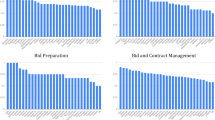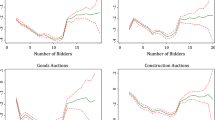Abstract
By estimating a flexible nonlinear regression model of savings on an original dataset of service procurements conducted by the Spanish Armed Forces, this paper provides robust and precise novel econometric evidence on the extent and sources of cost savings in public procurement. The net effect on savings of the policy-amenable and economically advantageous variables that we estimate, such as the size of the procured function, the importance of price in the contract award criteria, and the number of bidders who participate in the tendering, may help contracting agencies to select management practices and to forecast the price paid out. We find that savings increase proportionally to the size of the procured function, that an increase of 10 percentage points in the importance of price increases savings by approximately 2% of the function’s size, and that savings are generally reduced by restricting the number of bidders. A comparison with estimates reported in previous studies is also made.


Similar content being viewed by others
Notes
The study by Domberger et al. (2002) uses New Zealand Army data.
A new public procurement law, which is a transposition of the EU procurement directives 2014/23/UE, 2014/24/UE, and 2014/25/UE, is expected to be passed in Spain by the end of 2017.
When the contracting dossier value was difficult to pinpoint, there was overriding urgency, or a contract had previously been declared void, among other circumstances, the purchase could be negotiated with at least three potential providers.
In the words of Carrick (1988), since competition stimulates the quest for better production methods, “the winning bidder usually acquired some unique insight on how to perform the contractual task.”
As in the paper by Snyder et al. (2001), the fit in the savings regression was much better with the cost estimate entering in log form.
The probit estimation included the above-mentioned explanatory variables as additional regressors, and its R-squared, calculated as one minus the ratio of the log likelihood of the fitted function to the log likelihood of a function with only an intercept, was .42.
Wooldridge (2010) calls (5) a semirobust variance matrix estimator, as it assumes correct specification of \(m\left( {\mathbf{x}_i ,{\varvec{\upbeta }};\lambda } \right) \).
A total of 93 awarding committee meeting minutes (pertaining to the same number of procurements) were published in PLACE. The 11 among them which contain a request to justify prices took, on average, 10.9 weeks to award, whereas the other 82 took 6.0 weeks. Only in 2 cases was the winning bidder disqualified, which generated an 8% reduction in savings on average.
A linear regression of the natural logarithm of the winning bid on the explanatory variables for savings revealed that having conducted five additional procurements is associated with a 0.4% increase of the winning bid.
The variance of the difference between the two estimators was estimated using the paired bootstrap technique with 500 replications.
The dummy variable for whether the contract will allow for extra payments is removed from \(\mathbf{x}\) because it was 1 in only two cases.
References
Albano GL, Dimitri N, Perrigne I, Piga G (2006) Fostering participation. In: Dimitri N, Piga G, Spagnolo G (eds) Handbook of procurement. Cambridge University Press, New York, pp 267–292
Cameron LJ (2000) Limiting buyer discretion: effects on performance and price in long-term contracts. Am Econ Rev 90:265–281
Carrick PM (1988) New evidence on government efficiency. J Pol Anal Manag 7:518–528
Decarolis F (2014) Awarding price, contract performance, and bids screening: evidence from procurement auctions. Am Econ J Appl Econ 6:108–132
Dimitri N, Piga G, Spagnolo G (2006) Handbook of procurement. Cambridge University Press, New York
Domberger S, Meadowcroft SA, Thompson DJ (1986) Competitive tendering and efficiency: the case of refuse collection. Fisc Stud 7(4):69–89
Domberger S, Hall C, Li EAL (1995) The determinants of price and quality in competitively tendered contracts. Econ J 105:1454–1470
Domberger S, Jensen PH, Stonecash RE (2002) Examining the magnitude and sources of cost savings associated with outsourcing. Public Perform Manag Rev 26:148–168
Drukker DM (2002) Bootstrapping a conditional moments test for normality after tobit estimation. Stata J 2(2):125–139
Fernández Roca JM (2011) Viabilidad y costes de la externalización de servicios en el ámbito de las Fuerzas Armadas. Dissertation, National Distance Education University
Goldberg VP (1977) Competitive bidding and the production of precontract information. RJE 8(1):250–261
Gourieroux C, Monfort A, Trognon A (1984) Pseudo maximum likelihood methods: theory. Econometrica 52(3):681–700
Granger CWJ, King ML, White H (1995) Comments on testing economic theories and the use of model selection criteria. J Econom 67:173–187
Harrington JE Jr (2008) Detecting cartels. In: Buccirossi P (ed) Handbook of antitrust economics. MIT Press, Cambridge, pp 213–258
Hausman JA (1978) Specification tests in econometrics. Econometrica 46(6):1251–1271
Leibenstein H (1966) Allocative efficiency vs. X-efficiency. Am Econ Rev 56(3):392–415
Li T, Zheng X (2009) Entry and competition effects in first-price auctions: theory and evidence from procurement auctions. Rev Econ Stud 76(4):1397–1429
Lyon TP (2006) Does dual sourcing lower procurement costs? J Ind Econ 4:223–252
MacDonald P (2010) Economics of military outsourcing. Dissertation, University of York
Mantel N, Myers M (1971) Problems of convergence of maximum likelihood iterative procedures in multiparameter situations. J Am Stat Assoc 66(335):484–491
Marshall RC, Marx LM (2012) The economics of collusion: cartels and bidding rings. MIT Press, Cambridge
McAfee RP, McMillan J (1992) Bidding rings. Am Econ Rev 82(3):579–99
Nishii R (1988) Maximum likelihood principle and model selection when the true model is unspecified. J Multivar Anal 27:392–403
Pagan A, Vella F (1989) Diagnostic tests for models based on individual data: a survey. J Appl Econ 4(December):S29–S59
Pinkse J, Tan G (2005) The affiliation effect in first-price auctions. Econometrica 73(1):263–277
Ramsey JB (1969) Tests for specification errors in classical linear least-squares regression analysis. J R Stat Soc B 31(2):350–371
Schwarz G (1978) Estimating the dimension of a model. Ann Stat 6(2):461–464
Snyder CM, Trost RP, Trunkey RD (2001) Reducing government spending with privatization competitions: a study of the Department of Defense experience. Rev Econ Stat 83(1):108–117
Spulber DS (1990) Auctions and contract enforcement. J Law Econ Organ 6(2):325–344
Wilhelm MO (2008) Practical considerations for choosing between tobit and SCLS or CLAD estimators for censored regression models with an application to charitable giving. Oxf Bull Econ Stat 70(4):559–582
Wooldridge JM (1992) Some alternatives to the Box–Cox regression model. Int Econ Rev 33(4):935–955
Wooldridge JM (2010) Econometric analysis of cross section and panel data, 2nd edn. MIT Press, Cambridge
Author information
Authors and Affiliations
Corresponding author
Ethics declarations
Conflict of interest
The authors declare that they have no conflict of interest.
Additional information
We are indebted to Andrés Magallón for invaluable advice throughout this project. Thanks also to Jorge Rosell for encouragement, and to two anonymous referees, Ricardo Bueno, Manuel García, Luis Lanchares, J. Carlos Soto, and seminar participants at the Department of Business Economics of the University of the Balearic Islands, the XXIV Public Economics Meeting, and the 34èmes Journées de Microéconomie Appliquée for helpful comments and suggestions. This research was supported by Centro Universitario de la Defensa de Zaragoza Grant 2015-06.
Electronic supplementary material
Below is the link to the electronic supplementary material.
Rights and permissions
About this article
Cite this article
Chapela, J.G., Labeaga, J.M. & Medrano, L.A. Further econometric evidence on the extent and sources of cost savings in competitively tendered contracts. Empir Econ 56, 679–701 (2019). https://doi.org/10.1007/s00181-017-1365-8
Received:
Accepted:
Published:
Issue Date:
DOI: https://doi.org/10.1007/s00181-017-1365-8




